

From Half Day to Route 66, from 'the Greek' to 'Wilk,' an Illinois drag racing primer
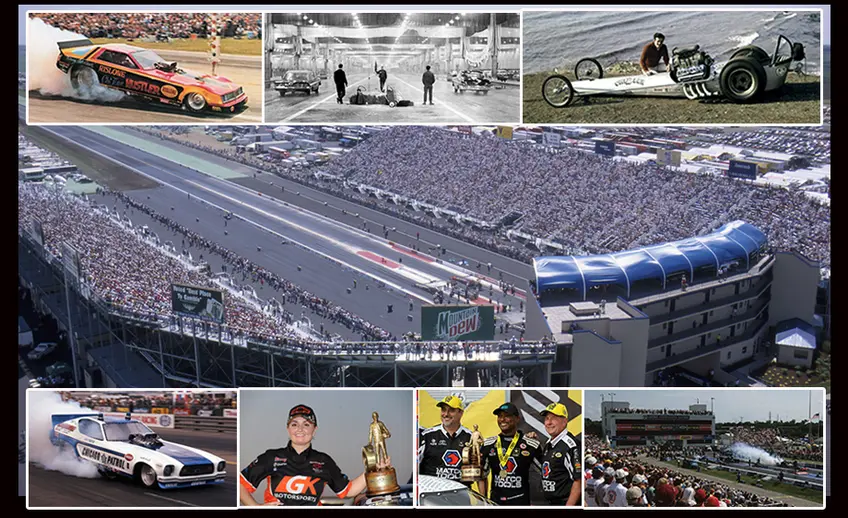
Next weekend, the NHRA Camping World Drag Racing Series will take its official return to Route 66 Raceway in Joliet, Ill., to continue the state’s 70-year love affair with drag racing.
According to Mel Bayshore’s encyclopedic Drag Strip List, there have been 40 dragstrips that have hosted race cars since the first, Half Day Speedway, opened in 1952, to today’s fabulous Route 66 Raceway in Joliet, which will host the Gerber Collision & Glass NHRA Route 66 Nationals presented by Peak, and World Wide Technology Raceway in Madison, Ill., home of the annual NHRA Midwest Nationals.
The Prairie State also gave us a long, long list of fighting Illini to battle down these dragstrips, starting with the legend himself, Chris “the Greek” Karamesines and, of course, Don and Tony Schumacher, as well as legendary teams like the Farkonas-Coil-Minick Chi-Town Hustler and the Mr. Norm Funny Cars out of the Chicagoland Grand-Spaulding Dodge dealership, plus early quarter-mile mainstays Arnie Beswick, Bobby Vodnik, Ron Colson, Cliff “the Chicago Kid” Brown Sid Seely, Jim Paoli, Bill Pryor, Ron Correnti, Ron O’Donnell, Ed O'Brien, Ron Pellegrini, John Pott, Fred Mandoline, and Fred Hagen, to name but a few.
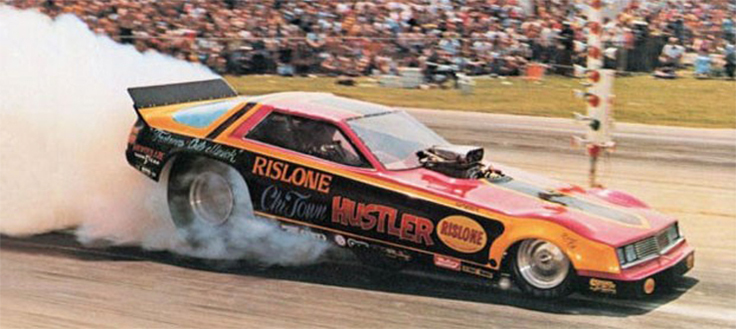
There have been a number of drag racing machines over the years to invoke the name of this great city in their pursuit of quarter-mile notoriety, and the Chi-Town Hustler ranks right at the top, both in terms of longevity and impact, which extended from their trademark long, smoky burnouts of the 1960s through two world championships with Austin Coil and driver Frank Hawley.
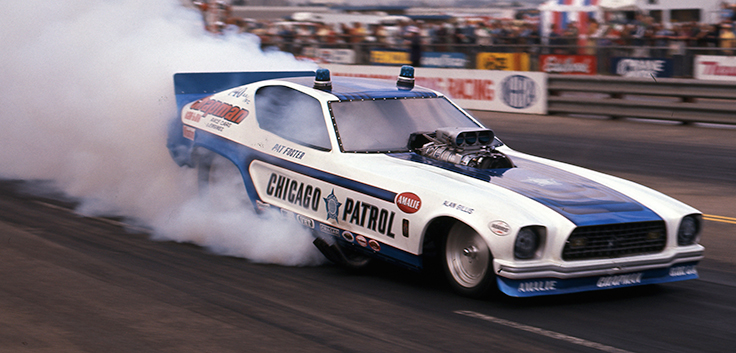
Funny Cars of the 1970s might remember the Chicago Patrol Mustang II, which was driven by a host of talented flopper shoes, including Pat Foster, Colson, Dale Pulde, and O'Brien, among others. The car's unforgettable gimmick was actual rotating blue police-light bubbles on the roof. For a time, it served as a promotional device for the Chicago Police Department.

There were plenty of other Chicago-named cars plying their trade on the quarter-mile. In the mid-1970s, Brown had the Chicago Kid Mustang, Correnti had the Chicago Charger '71 Dodge, and Vic Cecelia fielded The Chicagoan alky flopper, which later was run by crew chief Pat Cress under the same name and colors. Wyatt Radke drove Terry Joyce's Chicago Trapper Beretta Funny Car, Mike Faser the Chicago Fire Funny Car and Fuel Altered entries, and jet-car racer Bill Mattio also ran a car named Chicago Fire. The Chicago Rush Mustang II Alcohol Funny Car from the mid-'80s to the early '90s, alternatively driven by Chuck Scherr and Dan Sullivan until they took the name into the jet dragster ranks, and Don Colosimo had a Top Fueler called the Chicago Missile and Harry Claster a '68 Barracuda flopper named after himself, Chicago Harry.
Today, the flag is mostly carried by Funny Car stalwarts Tim and Daniel Wilkerson, Dale Creasy Jr., Bob and Bobby Bode, and Justin Schriefer, and Top Fuel’s TJ Zizzo and Jake Opatrny in the Pro classes, and three-time Comp world champ Bruno Massel Jr. leads the Sportsman standouts.

By all accounts, “the Greek” made his first passes down a dragstrip in 1953 on the half-mile-long airport dragstrip in Half Day, Ill., in the A/Street Roadster class and set track records of 12.21 and 122 mph on pump gas. (The city was reportedly named “Half Day” when it was founded in 1863 because it was a half-day ride by carriage from Chicago.)
According to Bayshore, Half Day, the brainchild of Andy Granatelli and the dragstrip, was set up on an outlying satellite airfield used by nearby Glenview Naval Air Station during World War II and was part of what was known as Maremont Speedway. The Automobile Timing Association of America (ATAA) first conducted drag races there starting on April 6, 1952, but the track was shut down the following year.
According to Bayshore’s Illinois page, here are the 40 tracks that called Illinois home, by year of founding. Only eight of which (denoted with an asterisk) are still running in some fashion today.
Half Day Speedway |
1952 |
Champaign "Drag Strip" |
1953 |
Lawrenceville Municipal Airport |
1954 |
Oswego Drag Raceway |
1954 |
Seneca Dragstrip |
1954 |
Monroe "Drag Strip" |
1955 |
Parks Metropolitan Airport (Maplewood) |
1955 |
Rankin "Drag Strip" |
1955 |
Camp Ellis /Canton) |
1956 |
Cordova Dragway/Quad City Drags * |
1956 |
Illiopolis "Drag Strip" |
1956 |
Effingham "Drag Strip" |
1957 |
Greater Peoria Dragstrip/Boondocks Dragway |
1957 |
Morgan County Fairgrounds |
1957 |
Alton Dragway |
1958 |
Greene County Fairgrounds |
1958 |
Quincy Urban Area Drag Strip |
1956 |
Waverly Dragway |
1959 |
Pleasant Grove Drag Strip/Drag City |
1960 |
Route 88 Dragway Strip |
1960 |
Southern Illinois Dragway |
1960 |
International Amphitheatre |
1962 |
Shifters Dragway |
1962 |
White Hall Drag Strip |
1962 |
Accelaquarter Raceway * |
1963 |
Nashville Dragway |
1963 |
Tri-City Speedway |
1963 |
Rockford Dragway/Byron Dragway * |
1964 |
Speedbowl Park |
1964 |
Riverview Drag Strip |
1965 |
Coles County Dragway * |
1966 |
Fairfield Drag Strip |
1966 |
Beardstown Drag Strip |
1967 |
St. Louis International Raceway/Gateway Motorsports Park/World Wide Raceway * |
1967 |
Meadowdale International Raceway |
1968 |
Midstate Dragway/Central Illinois Dragway * |
1969 |
Motion Raceway |
1970 |
CMW Dragway (Paris) |
1971 |
I-57 Drag Strip/Ellis I-57 Drag Strip * |
1972 |
Route 66 Raceway * |
1998 |
On this list, a number of names should jump out, including Alton Dragway, which in April 1960 gave Karamesines a much-debated “first” 200-mph time slip; current NHRA member tracks Coles County Dragway in Charleston and Byron Dragway in Byron, Ill., the latter of which had a long and rich history of Funny Car match racing back in the 1960s and ‘70s; and Cordova Dragway, longtime home of the World Series of Drag Racing event.

The oddball standout on the list is the International Amphitheatre, which for two years (late 1962-64) hosted the first indoor drag races. According to Bayshore’s site, “steel guard rails were installed on each side of the 60-foot-wide racing strip. The slippery concrete slab track was 440 feet long, with a 660-foot-long shut-down area. The track record was a paltry 81.81 mph, understandable based on the conditions.

According to Midwest drag racing historian Bret Kepner, to the vast majority of fans who are aware of a massive racing complex in Madison, Ill., currently known as World Wide Technology Raceway, the facility’s dragstrip has been in operation since it was opened in 1967 as an eighth-mile track and that, over a period of 55 years, the track has blossomed into a state-of-the-art, multi-purpose masterpiece of land use, which includes a 1.25-mile oval and a two-mile road course. Those fans would be wrong.
The current World Wide Technology Raceway and that original eighth-mile are not only two completely different dragstrips but are located on two completely different pieces of property.
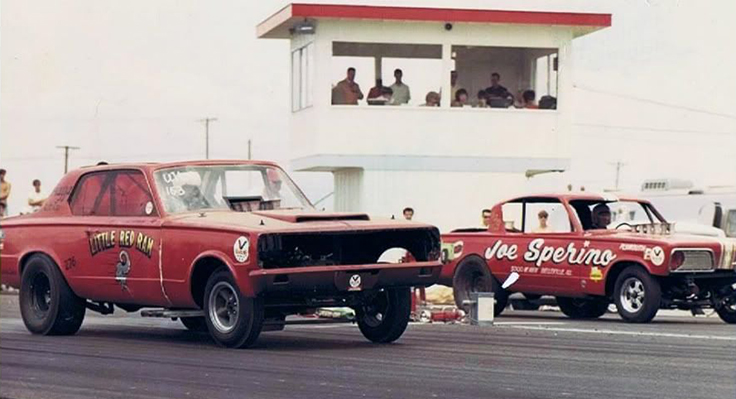
Opening Day competition at the new St. Louis International Raceway Park in this June 1967, Ed Harris photo shows Hal Hammer's '65 Dodge Dart from St. Louis versus Claude Bradshaw in Joe Sperino's injected nitro Hemi-powered '65 Barracuda. Note perfectly fresh asphalt.
According to Kepner, St. Louis International Raceway Park opened in June 1967, with an AHRA national event and enjoyed continued success with the track as it morphed through names like St. Louis International Raceway and St. Louis International Dragway. In June 1971, the track closed, and the dragstrip was repaved and extended, and it reopened as quarter-mile St. Louis International Raceway. After a series of failed events, the track went into bankruptcy in November 1986 after failures with the new road course, and it reopened in July 1987 under new leadership and briefly joined the NHRA member track family in 1988. In 1989, under yet another new owner, the track was renamed Gateway International Raceway and became an IHRA track until 1992, when it rejoined the NHRA.
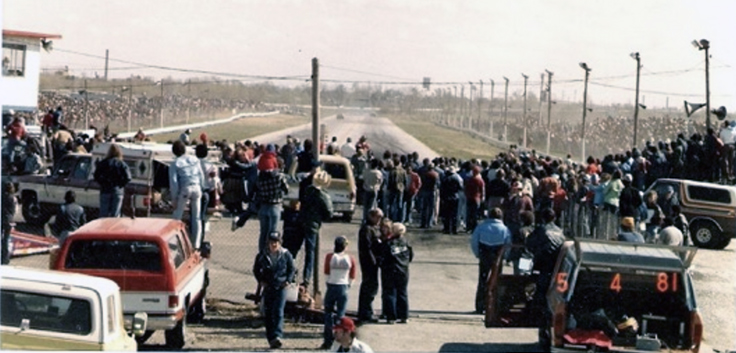
A May 4, 1981, image taken during an All-Pro Series Alcohol Dragster and Alcohol Funny Car meet shows essentially a full house at SLIR watching racers head due south toward Interstate 55-70, which runs directly behind the timing tower of the new WWTR. (Jim Sanders photo)
Under new owner Chris Pook, the facility was offered an NHRA national event if he could add a championship-caliber dragstrip to the new complex. Pook purchased land beyond the western border of the original property previously untouched by the 30-year history of the original track.
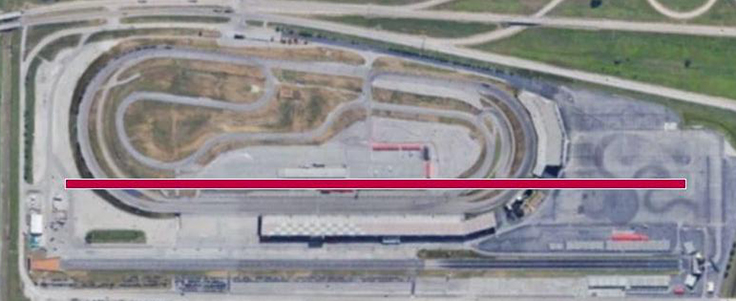
The is a composite satellite image based on a July 4, 2022 shot, which shows in red where the old St. Louis International track was located versus where the new dragstrip is on the property. (bottom of image)
The new dragstrip, running south-to-north in direct opposition to the old track, was located a mere 638 feet west of the still-operating GIR which, in May 1996, and was forced to curtail action to an eighth-mile because of construction of the new dragstrip and ran its final race in August 1996. Four weeks later, the new dragstrip opened for business. All was well until 2010 when the track went up for sale in the face of burgeoning debt but was rescued by Curtis Francois and reopened in March 2012, as Gateway Motorsports Park under NHRA sanction. The facility attracted all NASCAR series and gained an annual event on the Indycar schedule, and, of course, the NHRA national event has been held every year except for 2011 when the track was closed.
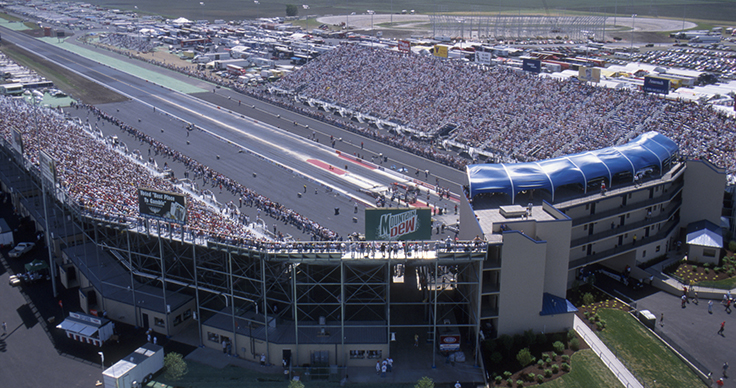
Construction of the 250-acre grounds that host Route 66 Raceway was completed in 1998 and included a two-mile,15-turn road course, a temporary one-mile off-road track inside the dirt oval, a 35-acre paved driving pad, and the 1.5-mile tri-oval Chicagoland Speedway. The dragstrip, with its wraparound grandstands, is considered the first “stadium” dragstrip due to that construction (though you might argue that Texas Motorplex has a similar yet smaller layout).
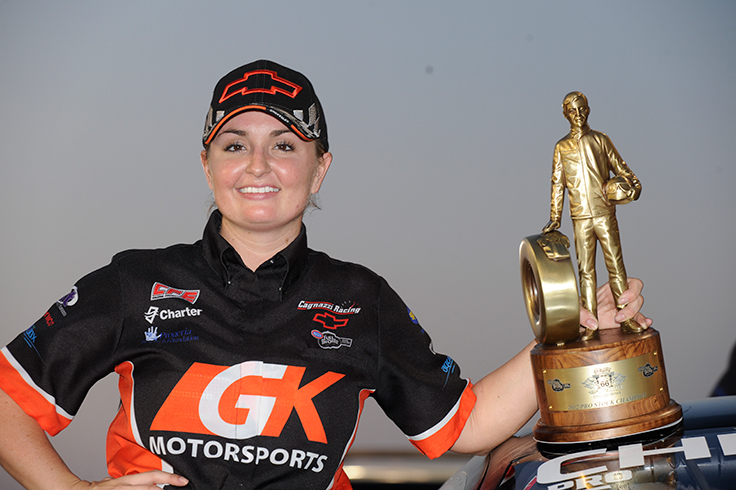
Route 66 Raceway has since been host to a number of historic moments, including John Force's 86th career win in 2000, which broke his tie with Pro Stock icon Bob Glidden to make him the winningest driver in NHRA national event history, and Erica Enders' breakthrough win in 2012, where she became the first female Pro Stock winner in the then-40-year-plus history of the category, It also was the site of Jason Line's first Pro Stock win in 2004, when he defeated teammate Greg Anderson in the final, much as Enders would do eight years later. It also was the site of Frank Manzo's milestone 75th career win (2008) and the first 330-mph run by a Funny Car (Gary Scelzi, 2004).
The track, which from 2001-2005 hosted two national events a year, also was home to the JEGS Allstars for years and this year will host the first Pro Stock Callout event, a semi-throwback to when the track hosted the King Demon Pro Stock specialty event in the early- to mid-2000s.
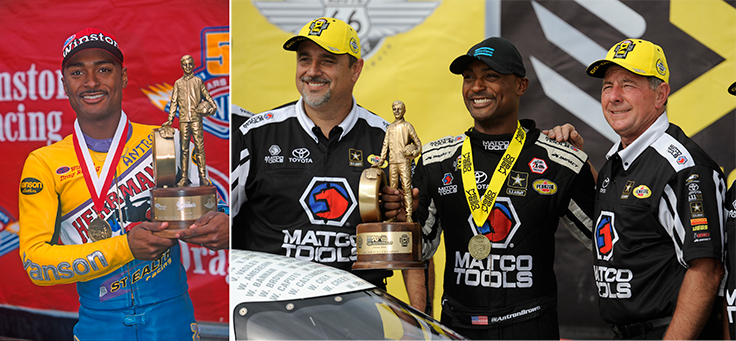
Jeg Coughlin Jr. owns the most wins at Route 66 Raceway, a half-dozen all in Pro Stock, while Antron Brown and Tony Schumacher each have five wins. Brown has won in two classes, Pro Stock Motorcycle (2000 and 2001) and Top Fuel (2012, '14, and '16), and Del Worsham and Gary Scelzi also both won in two classes (Top Fuel and Funny Car) in Chicago, Worsham three times in Funny Car (2001, '02, and .04) and once in Top Fuel (2011), while Scelzi won in Top Fuel (2000) and Funny Car (2005 and '07).
We're all excited to be heading back to Joliet, where we can continue to get our kicks at Route 66.
Phil Burgess can be reached at pburgess@nhra.com
Hundreds of more articles like this can be found in the DRAGSTER INSIDER COLUMN ARCHIVE
Or try the Random Dragster Insider story generator



















































